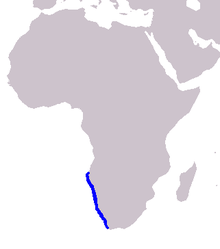- Haviside's dolphin
-
Haviside's Dolphin 
Conservation status Scientific classification Kingdom: Animalia Phylum: Chordata Class: Mammalia Subclass: Eutheria Order: Cetacea Suborder: Odontoceti Genus: Cephalorhynchus Species: C. heavisidii Binomial name Cephalorhynchus heavisidii
Gray, 1828Haviside's Dolphin range The Haviside's Dolphin (Cephalorhynchus heavisidii), or mistakenly the Heaviside's Dolphin, is a small dolphin that is found off the coast of Namibia and the west coast of South Africa. It is one of four dolphins in the genus Cephalorhynchus — the others being the Chilean Dolphin, Hector's Dolphin, and Commerson's Dolphin.
Contents
Name
The Haviside's Dolphin, whose binomial name references heavisidii, is actually named after a Captain Haviside who brought a specimen from Namibia to the United Kingdom early in the 19th Century. However, its name was once mis-spelled Heaviside, after a prominent surgeon, Captain Heaviside who collected cetacean and other animal species. The latter name stuck and is the most common in the popular literature. However, some authorities, including the Encyclopedia of Marine Mammals and Mammal Species of the World use the originally intended name of Haviside's Dolphin.
Population and distribution
Although sightings of the species are not uncommon off the Skeleton Coast of Namibia, Haviside's Dolphins have not been systematically studied by scientists. They have been recorded off the coast of northern Namibia at 17° S and as far south as the southern tip of South Africa. Sightings are often recorded from major population centres such as Cape Town and towns such as Walvis Bay. Sightings are likely from Lambert's Bay either from the shore or from boat trips run from the Harbour. No estimates of abundance exist.
Physical description
The Haviside's Dolphin is a fairly small dolphin, growing up to about 180 cm in length and weighing up to 75 kg. Their size and the bluntness of their heads leads these dolphins to often be mistaken for porpoises. The head is coloured a dark grey. The front half of the upper side and the flanks are a much lighter grey. The dorsal fin, fluke and back half of the back are again a darker grey colour. The underbelly is white and there are flashes of white on the flanks below the dorsal fin.
Males reach sexual maturity at about 7–9 years. Females reach breeding age at the same time. The gestation period is probably 10 months. Mating occurs in Spring and Summer. It is believed that females calf on average once every three years. The maximum known age of a Haviside's Dolphin is 20 years. This relatively short life span, coupled with the long calving period, causes a naturally low population growth rate. Therefore the species is particularly sensitive to being hunted.
Haviside's Dolphins are active and social animals. They typically congregate in groups of about 5–10 in number but sometimes in larger groups. They are able to swim fast. Part of their play and social activity is to jump vertically clear of the water, turn in the air, and fall back into the sea with virtually no splashing or noise.
Conservation
The Heaviside's dolphin is listed on Appendix II[2] of the Convention on the Conservation of Migratory Species of Wild Animals (CMS). It is listed on Appendix II[2] as it has an unfavourable conservation status or would benefit significantly from international co-operation organised by tailored agreements.
The Heaviside's dolphin is covered by the Memorandum of Understanding Concerning the Conservation of the Manatee and Small Cetaceans of Western Africa and Macaronesia (Western African Aquatic Mammals MoU).
References
- ^ Reeves, R.R., Crespo, E.A., Dans, Jefferson, T.A., Karczmarski, L., Laidre, K., O’Corry-Crowe, G., Pedraza, S., Rojas-Bracho, L., Secchi, E.R., Slooten, E., Smith, B.D., Wang, JY. & Zhou, K. (2008). Cephalorhynchus heavisidii. In: IUCN 2008. IUCN Red List of Threatened Species. Downloaded on 24 March 2009. Database entry includes a brief justification of why this species is of data deficient.
- ^ a b "Appendix II" of the Convention on the Conservation of Migratory Species of Wild Animals (CMS). As amended by the Conference of the Parties in 1985, 1988, 1991, 1994, 1997, 1999, 2002, 2005 and 2008. Effective: 5th March 2009.
- National Audubon Society: Guide to Marine Mammals of the World Reeves, Stewart, Clapham and Powell, (2002)
- Cephalorhynchus dolphins, Encyclopedia of Marine Mammals, p200-202, Stephen M. Dawson (1998) ISBN 0-12-551340-2
External links
- Convention on Migratory Species page on the Heaviside's dolphin
- Memorandum of Understanding Concerning the Conservation of the Manatee and Small Cetaceans of Western Africa and Macaronesia
Categories:- IUCN Red List data deficient species
- Oceanic dolphins
- Fauna of the Atlantic Ocean
- Animals described in 1828
Wikimedia Foundation. 2010.


